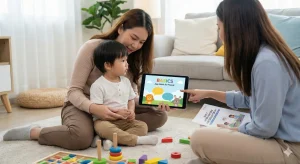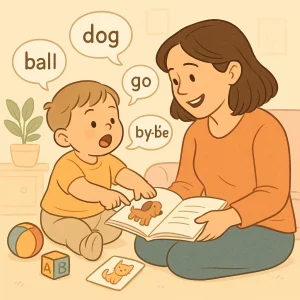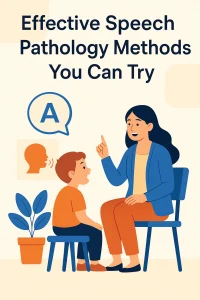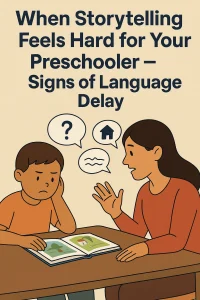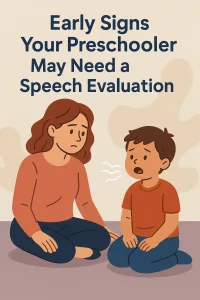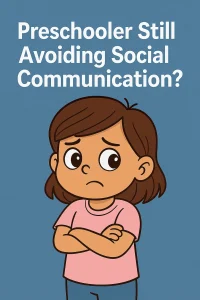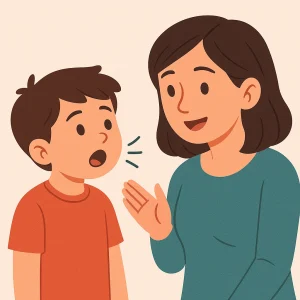Overcome Speech Apraxia in Kids: Effective Strategies
By Rajini D
Last Updated: February 9, 2024
Welcome to a journey of understanding and support for children with speech apraxia. Imagine knowing exactly what your child wants to say, but they just can’t get the words out right. This challenge is the reality for kids with speech apraxia, a condition that affects their ability to speak clearly and confidently. But here’s the good news: with the right approach, significant improvements are possible.
Our goal today is not just to inform but to empower you, the parents and caregivers, with practical, enjoyable activities that can make a real difference in your child’s speech development. We believe that learning should be fun, and when it comes to speech apraxia exercises for kids, engagement and enjoyment are key to success.
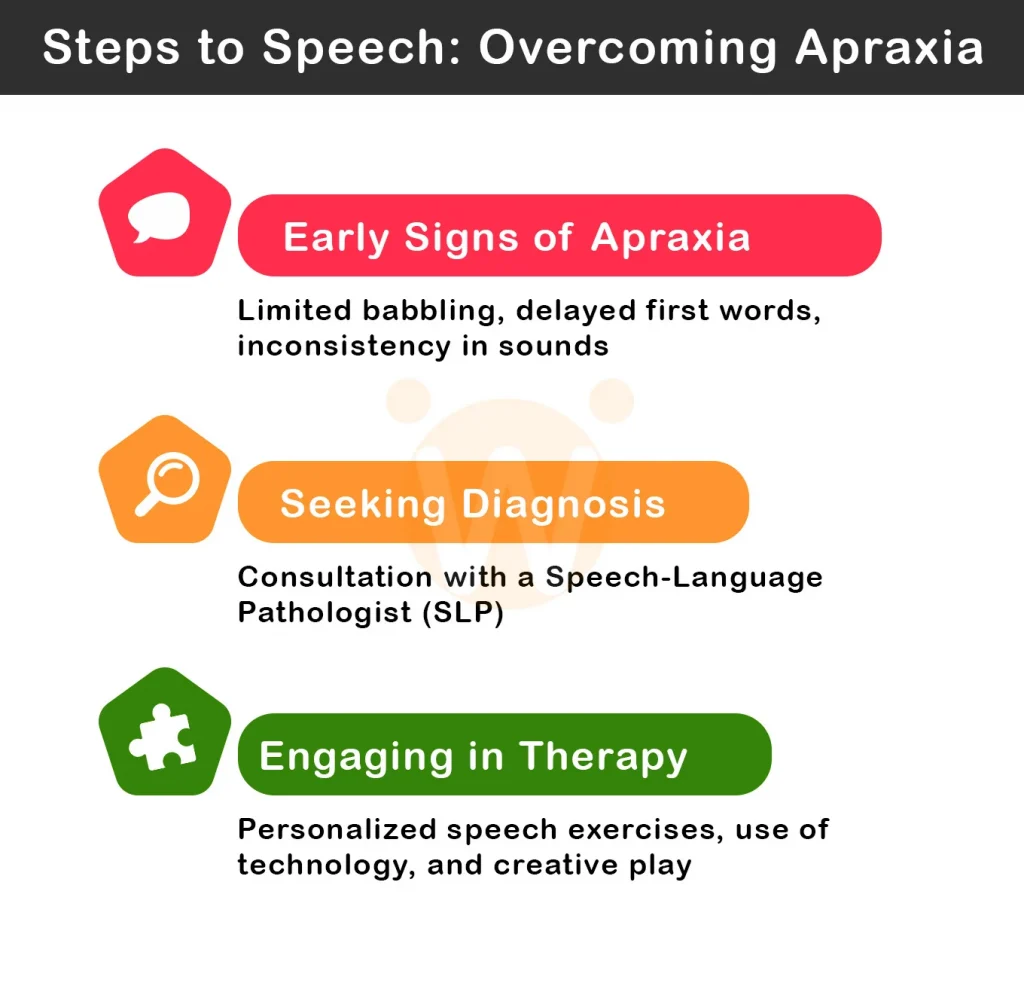
Understanding Speech Apraxia:
Understanding Childhood Apraxia of Speech (CAS) might seem daunting at first, but let’s break it down into simpler terms. Imagine a child who knows exactly what they want to say. They can think of the words in their mind, but when it comes to saying them out loud, the words just don’t come out right. This is the essence of CAS—a speech disorder that impacts a child’s ability to make accurate movements with their mouth when speaking.
CAS is not about muscle weakness or paralysis. Instead, it’s like the brain has trouble directing or coordinating the muscle movements necessary for speech. The child knows what they want to say, but their brain struggles to guide their speech muscles to produce the words correctly.
The significance of early and engaging interventions cannot be overstated. Early detection and intervention are crucial because they take advantage of the brain’s remarkable plasticity during the early years. Engaging in fun, tailored activities helps sustain a child’s interest and motivation, which are vital for making progress in overcoming speech apraxia.
While understanding Childhood Apraxia of Speech (CAS), it’s also helpful to differentiate it from other speech disorders, such as stuttering.
Starting with the Basics: Understanding Your Child’s Unique Needs
Before diving into the world of exercises and activities for speech apraxia, the first step is ensuring a proper diagnosis and understanding of your child’s specific speech needs. This journey often begins with a visit to a speech-language pathologist (SLP), a professional skilled in assessing and treating speech, language, and communication challenges. A detailed evaluation by an SLP can pinpoint the precise areas where your child needs support, setting the stage for targeted interventions.
Why is a personalized approach so critical? Just like every child has their own personality, every case of speech apraxia is unique. Some children might struggle with making certain sounds, while others may find it challenging to string sounds together into words or sentences. By identifying your child’s specific needs, an SLP can design a set of activities that are not just effective but also perfectly suited to your child’s interests and abilities.
Tailored activities can significantly improve speech skills because they address the root of the challenge head-on. They can transform abstract concepts into tangible, achievable goals, making the process of learning to speak correctly feel more like an exciting game than a daunting task. Moreover, these personalized activities ensure that practice is meaningful and directly related to the speech sounds or patterns your child finds challenging.
Incorporating fun, engaging activities into your child’s daily routine can lead to remarkable improvements. Whether it’s through games, storytelling, or interactive play, these exercises can help strengthen the neural pathways necessary for clearer speech. They also keep children motivated and eager to participate, which is half the battle won.
Understanding your child’s unique speech needs is crucial, as is distinguishing between common speech delays and more complex conditions like apraxia.
Engaging in Exercises and Games for Speech Apraxia
Transforming speech therapy into a series of fun and engaging activities can significantly boost a child’s progress and enthusiasm. Here are some tailored exercises designed to make learning enjoyable while effectively addressing the challenges of speech apraxia.
Exercise 1: Sound of the Day
Introduce the concept of a “Sound of the Day” to focus on specific speech sounds that your child finds challenging. This could be any sound, like “s,” “r,” or “m.” Incorporate this sound into daily routines by identifying objects around the house or in books that start with the chosen sound, encouraging your child to pronounce it. This repetition and focus not only make practicing fun but also integrate learning seamlessly into your everyday life.
Exercise 2: Storytime Adventures
Select books that contain repetitive uses of your child’s “Sound of the Day” or that focus on sounds they are working to master. Books with engaging stories and vibrant illustrations can capture a child’s imagination, making them more inclined to repeat sounds and words. This method transforms reading time into a lively speech therapy session, enhancing your child’s phonetic skills through the power of storytelling.
Also Read: The Speech Chain: Understanding How We Communicate
Exercise 3: Animal Sounds Interaction
Children love animals, making this exercise a perfect opportunity for learning through play. Spend time imitating animal sounds together, focusing on animals that produce the target sounds your child is practicing. This playful interaction not only teaches sound production in a fun way but also helps in building a connection between the sounds and their meanings, reinforcing motor planning for speech.
Exercise 4: Art and Craft for Speech
Engage in art and craft activities that allow your child to create objects representing words that contain their target sounds. While crafting, emphasize the name of the object and the sounds within it. This creative approach not only keeps the child engaged in the activity but also in the repetitive practice of specific sounds, enhancing their speech capabilities in a natural and enjoyable manner.
Art and craft for speech development also lay the groundwork for other skills, such as pre-writing, demonstrating the interconnectedness of speech and literacy.
By integrating these exercises into your routine, you’re not just helping your child overcome the challenges of speech apraxia; you’re also ensuring that the journey is filled with joy and discovery. Each activity is designed to make learning feel like play, making speech therapy something children can look forward to. Remember, the key to success is consistency, patience, and making sure that every learning opportunity is as enjoyable as it is educational.
Weekly Speech Exercise Planner
| Day of the Week | Exercise Type | Duration | Notes |
|---|---|---|---|
| Monday | Sound of the Day (S sound) | 15 mins | Focus on words like “sun,” “soap,” and “snake.” |
| Tuesday | Storytime Adventures | 20 mins | Read “Silly Sally” to emphasize the S sound. |
| Wednesday | Animal Sounds Interaction | 15 mins | Practice “moo,” “quack,” “neigh” with animal toys. |
| Thursday | Art and Craft for Speech | 30 mins | Create a “sea” collage emphasizing the S sound. |
| Friday | Digital Aids (Speech Blubs) | 20 mins | Use the app to practice S sounds with interactive games. |
| Saturday | Play Pretend (Grocery Store) | 30 mins | Use food items starting with S. Role-play as a shopkeeper. |
| Sunday | Review & Family Game Night | 30 mins | Review the week’s sounds with a game of “I Spy” or Charades, focusing on S sounds. |
Using animal sounds to engage children offers a playful way to improve speech, similar to various techniques used in speech and language therapy.
Digital Aids and Apps
In our digital age, technology plays a pivotal role in enhancing traditional speech therapy techniques, offering a supplementary bridge between sessions with a speech-language pathologist and home practice. Speech therapy apps for kids have become an invaluable tool, providing fun, interactive ways to practice speech exercises. These apps are designed with engaging interfaces, rewarding systems, and a variety of activities that cater to different aspects of speech development, such as articulation, vocabulary building, and understanding of language.
It’s important to view these digital aids as supplements to, not replacements for, personal interaction and traditional exercises. They offer a convenient and exciting way for children to practice their speech skills daily. For instance, apps that turn speech exercises into games can motivate children to practice more often, making speech practice feel less like a chore and more like play.
As we integrate technology through speech therapy apps, exploring the effectiveness of online speech therapy can provide further insights.
Recommended Speech Therapy Apps
| App Name | Target Skill | Age Range | Description |
|---|---|---|---|
| Speech Blubs | Articulation, Vocabulary | 4-10 years | Engaging app with interactive activities designed to improve speech and expand vocabulary. |
| Articulation Station | Articulation | All ages | Comprehensive app providing exercises for every sound, perfect for customized speech practice. |
| Little Stories | Language Development | 3-7 years | The App is filled with short stories to enhance language development and comprehension skills. |
| Fun with Fluency | Fluency | 6-12 years | Interactive activities focusing on improving speech fluency and reducing stuttering. |
| Lively Letters | Phonemic Awareness | 4-8 years | Uses music and visuals to teach letter sounds, improving phonemic awareness and reading skills. |
| TallyTots Counting | Vocabulary, Numbers | 3-5 years | Fun app that combines learning numbers with vocabulary development through interactive games. |
| TalkingTiles | Communication | All ages | A customizable AAC app that helps children with severe speech impairments communicate effectively. |
Daily Activities as Learning Opportunities
Integrating speech exercises into daily activities is an effective way to reinforce learning in a natural setting, making practice a part of your child’s routine. This approach ensures that children are not only practicing their speech skills during therapy sessions but throughout the day, in various contexts, which can significantly enhance their learning and retention.
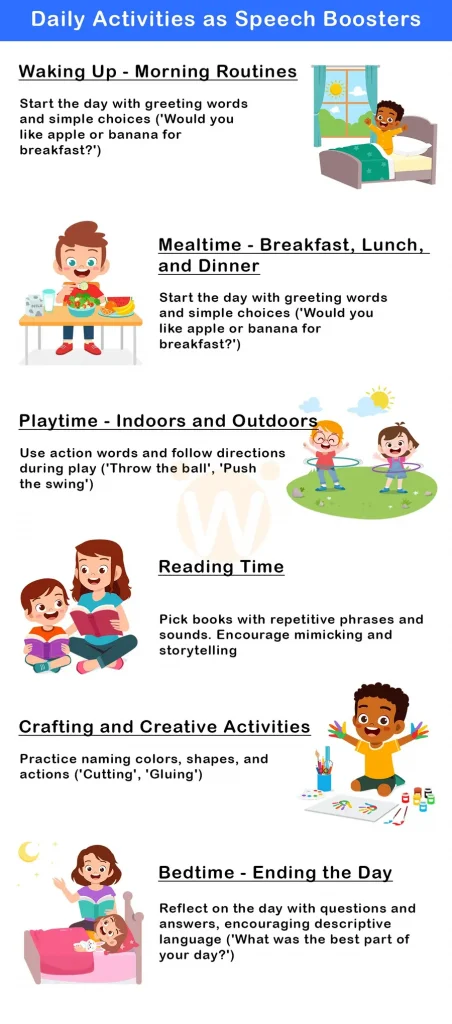
For example, meal times can be an opportunity to practice naming foods, describing their textures, or discussing their colors. Simple conversations during these moments can encourage the use of target sounds or words. During playtime, engage in activities that involve following directions or storytelling, which can help in practicing speech sounds and language use in an enjoyable, low-pressure environment.
Incorporating speech exercises into everyday tasks not only provides ample practice but also helps children realize the practical application of their speech skills, enhancing their motivation and engagement. It turns the world into a classroom, where every activity, from dressing up to gardening, becomes a chance to learn and practice speech.
Incorporating speech exercises into daily routines can be complemented by home-based occupational therapy activities, enhancing overall development.
Creating a Supportive Environment
Creating a nurturing and supportive environment is crucial for children with speech apraxia. As parents and caregivers, your patience, positivity, and consistency form the foundation of your child’s progress and confidence in their speech journey. Here are some tips for fostering this supportive atmosphere:
Be Patient: Understand that progress in speech apraxia can be slow and varies greatly from one child to another. Celebrate small victories and remain patient through the challenges.
Stay Positive: Your attitude greatly influences your child’s motivation and self-esteem. Focus on effort rather than perfection, and always encourage their attempts to communicate.
Consistency is Key: Regular practice is essential for improvement. Incorporate speech exercises into your daily routine and stay consistent with the strategies recommended by your speech therapist.
Collaboration with a speech therapist is also vital. They can offer tailored advice specific to your child’s needs and help track progress over time. Open communication with your therapist ensures that the strategies you use at home complement those used in therapy sessions, creating a cohesive approach to your child’s speech development.
Creating a nurturing and supportive environment is key, not just for children with speech apraxia but also for those with other developmental challenges, as outlined in our tips for parenting an autistic child.
Conclusion
Navigating the path of speech apraxia with your child involves a blend of patience, innovation, and joyous celebration of every achievement along the way. Through engaging exercises like the “Sound of the Day,” captivating storytime adventures, playful animal sound interactions, and creative art projects, we’ve uncovered methods that intertwine speech skill enhancement with the fabric of daily fun and learning. The introduction of digital aids, such as speech therapy apps, further complements traditional exercises, ensuring that children remain engaged and motivated.
Creating a supportive environment is paramount, with patience, positivity, and consistency from parents, caregivers, and speech therapists forming the foundation of effective speech development. It’s crucial to work closely with professionals who can offer personalized guidance tailored to your child’s unique needs. Wellness Hub is here to support you on this journey, providing resources, advice, and a community that understands the intricacies of speech apraxia. We believe in the power of collective effort to unlock each child’s potential, encouraging clear and confident self-expression. Visit Wellness Hub for more insights and support, and remember, together, we can help every child find their voice.
Frequently Asked Questions
1. What is Childhood Apraxia of Speech (CAS)?
Childhood Apraxia of Speech (CAS) is a motor speech disorder where children have difficulties speaking clearly due to the brain’s inability to properly coordinate the muscle movements necessary for speech. Despite knowing what they want to say, children with CAS struggle to make the correct sounds, syllables, and words.
2. How Can I Tell if My Child Has Speech Apraxia?
Diagnosing CAS requires a comprehensive evaluation by a speech-language pathologist (SLP). Common signs include limited babbling during infancy, delayed onset of first words, difficulty combining sounds, and inconsistency in speech production.
3. What Are Some Effective Speech Apraxia Exercises for Kids?
Effective exercises include the “Sound of the Day” activity, storytime adventures with repetitive sound books, animal sounds interaction, and engaging in art and craft to practice speech sounds. Incorporating technology through speech therapy apps can also be beneficial.
4. How Often Should We Practice Speech Exercises at Home?
Consistency is key. Daily practice, integrated into fun and engaging activities, helps reinforce learning. Work with your child’s SLP to establish a routine that fits your child’s needs and keeps them motivated.
5. Can Speech Apraxia Affect a Child’s Learning and Development?
While CAS primarily affects speech production, it can impact language development and social interactions. Early and consistent intervention can significantly improve outcomes and support a child’s overall development.
6. Are There Any Recommended Speech Therapy Apps for Kids with Apraxia?
Yes, several apps are designed to make speech practice engaging for children with apraxia. While specific app recommendations can vary, look for ones developed with input from speech-language pathologists and that focus on articulation, phonological awareness, and interactive play.
7. How Can I Support My Child’s Speech Therapy at Home?
Engage in the recommended exercises and activities daily, maintain a positive and encouraging environment, and ensure consistent practice. Collaboration with your child’s speech therapist is crucial to tailor activities to your child’s specific needs.
8. Where Can I Find More Resources and Support for Childhood Apraxia of Speech?
Wellness Hub offers a wealth of resources, including articles, tools, and a supportive community for parents of children with speech apraxia. Visit our website to explore materials and connect with experts and other families navigating similar challenges.
9. What Role Do Play and Creativity Play in Speech Therapy for Apraxia?
Play and creativity are fundamental to speech therapy for apraxia, transforming learning into an enjoyable experience. Activities like pretend play, storytelling, and crafting engage a child’s imagination and motivation, facilitating natural speech practice.
10. How Important Is Early Intervention for Children with Speech Apraxia?
Early intervention is crucial for children with speech apraxia. Starting therapy at a young age takes advantage of a child’s developing brain and its ability to adapt more readily to new learning and speech patterns. Early intervention can significantly improve speech clarity, communication skills, and confidence, laying a strong foundation for language development and academic success.
About the Author:
Rajini, Speech-Language Pathologist:
Rajini is a dedicated Speech-Language Pathologist with a focus on developmental speech and language disorders in children and rehabilitation in adults. With a passion for helping each individual find their voice, Rajini brings a wealth of experience and a heartfelt approach to therapy. At Wellness Hub, she’s part of a team that values innovation, compassion, and results-driven practices.
Book your Free Consultation Today
Parent/Caregiver Info:
Client’s Details:
* Error Message
